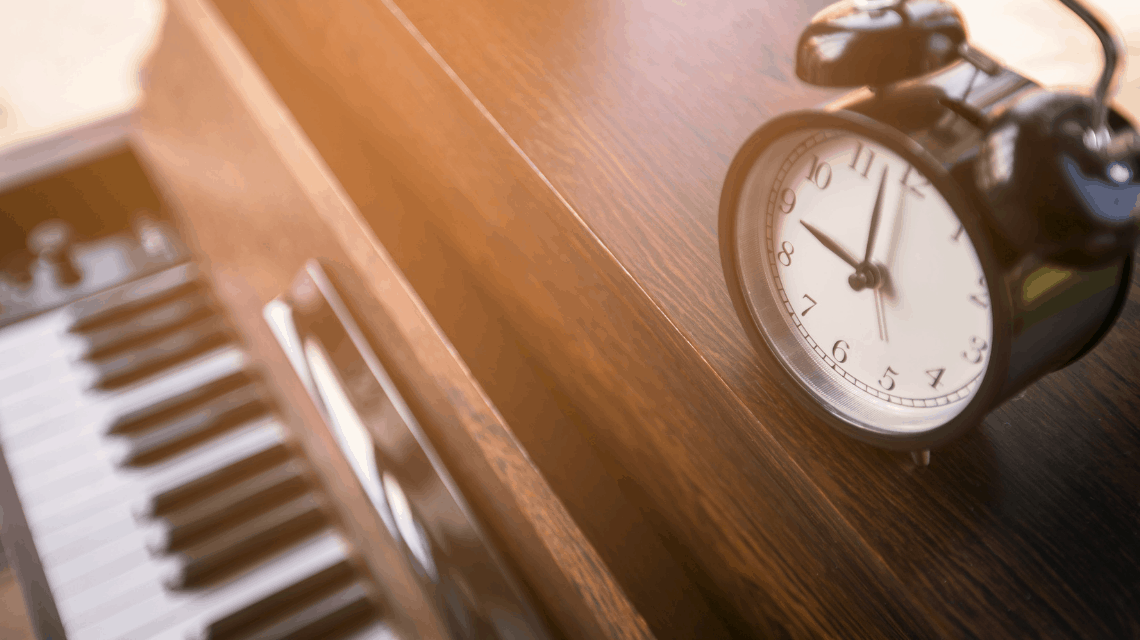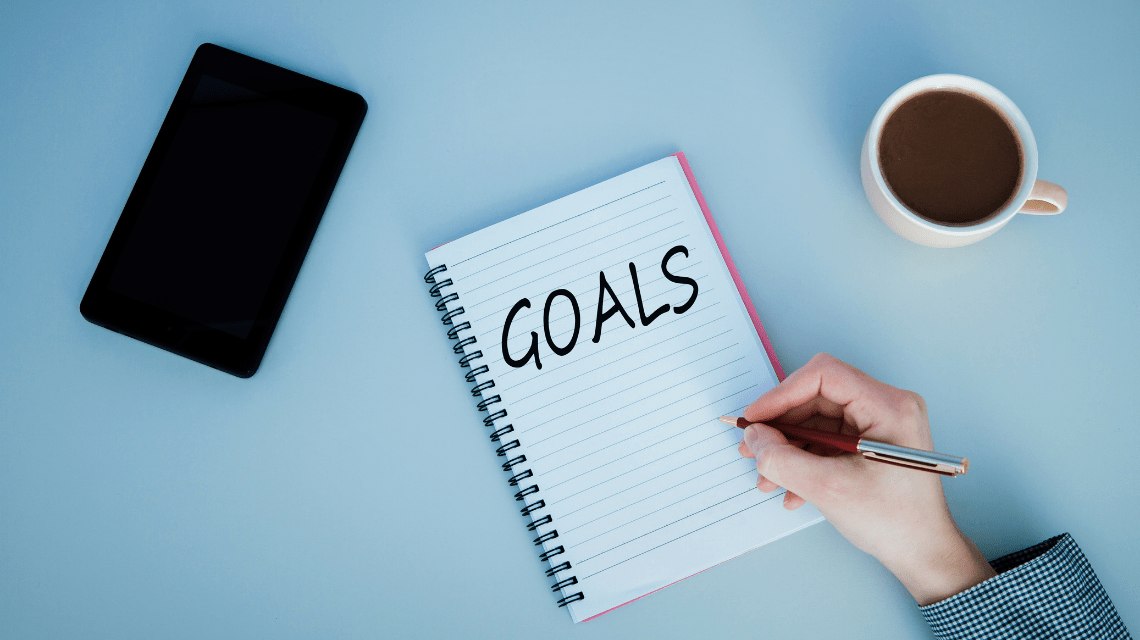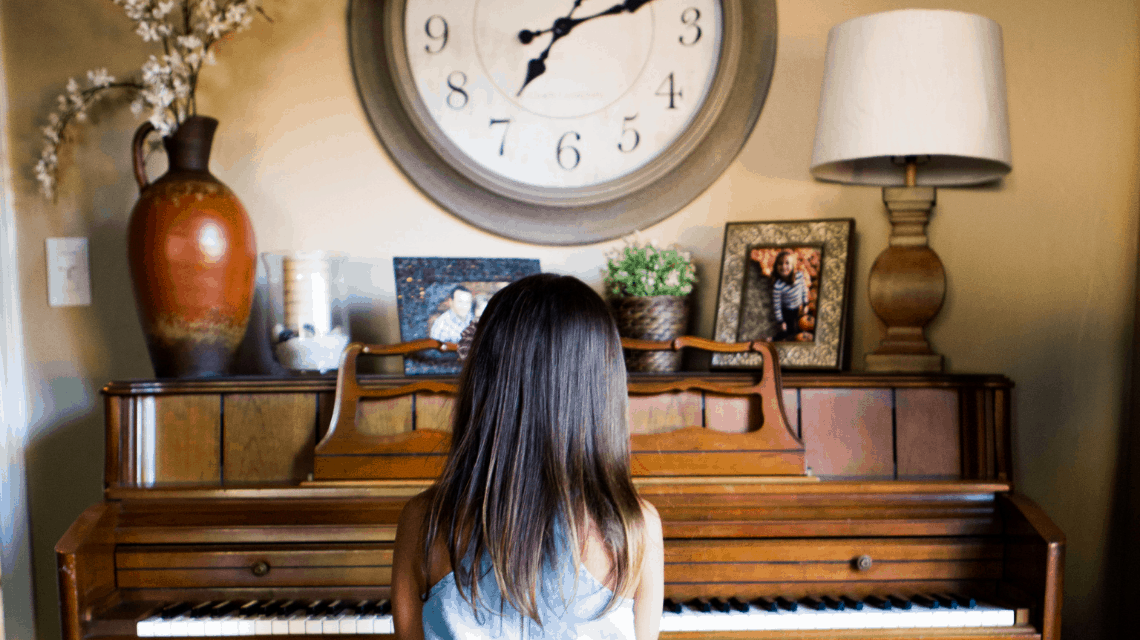How Much Should You Practice The Piano Each Day?

Adult beginners and parents of new piano students often wonder how long to practice the piano or how many days a week to practice the piano.
This is a great question, although the exact lengths of practice time suggested can vary greatly depending on a number of different factors.
It seems like “traditional” piano practice advice was to practice 30 minutes a day. Parents of piano students or adults returning to the piano might remember their childhood piano teacher encouraging that magic number of 30 minutes of practice each day.
However, 30 minutes is really just an arbitrary amount of time, and while it might be the right amount of time for some piano students to accomplish some tasks at the piano, it’s not the right amount of time for everyone in every situation.
If you’re trying to find the right amount of practice time for your household, let’s explore 4 questions to ask yourself plus 4 tips to help you maximize your practice time.
What is your goal?
This is a really important starting place when trying to figure out how much to practice. Piano goals can vary from recreational goals to high-achieving goals, and of course, there is a lot of gray area in between these two types of goals.

Recreational goals might look like this:
- I want to learn the piano so I can play duets with my daughter at Christmastime.
- My child wants to learn the piano to learn how to play his favorite Star Wars songs.
- Playing the piano seems like a nice way to unwind in the evenings after work.
- My child enjoys music and we just want to keep her interested in music through piano lessons.
Achievement-based goals might look like this:
- My child wants to major in music in college and he needs to prepare for auditions.
- I want to learn hymns so that I can play at my church.
- We want to enter our child in piano contests & festivals and participate in all of the recitals.
- I want to study classical music and become proficient playing advanced piano pieces.
You can imagine that there is a huge variation in the amount of time that it takes to achieve these goals. And, really, 30 minutes might be adequate some days, but it probably isn’t the right answer in most of these situations.
What is your level?
It really doesn’t make a lot of sense to expect a brand-new beginning piano student, whether a child or adult, to practice for 30 minutes a day.
Beginner piano songs often take one minute or less to play. Even if the student is playing it very slowly or stopping to work on difficult spots, it’s unlikely that anyone could fill 30 minutes playing a one minute song, or even 3-5 one minute songs. So, in the early stages, maybe 10-15 minutes is enough time to help you or your child reach your goals.
Of course, if you just enjoy practicing and playing or if you are moving along really quickly, you’ll want to add more time to that.
But, in the first several weeks, it doesn’t take a huge amount of time to practice. And, trying to do too much early on can lead to fast burn out or over-practicing of poor technique.
How much time do you have?

This might seem obvious, but it’s really important to set realistic practice goals that are feasible and achievable for your household.
Between school and work schedules, many families are away from their homes for much of the day. There might even be a couple of days each week that you are away from your piano all day and there simply isn’t time to practice piano.
Think through the logistics of your week and plan practice times for practical, productive times of the day.
What can you do to form a consistent routine?
Consistency is key for beginning pianists. It’s almost more important to focus on getting to the piano as many days as possible than it is to worry about how much time to spend once you are there.
For kids and adults trying to form new habits, sometimes the most challenging part of practicing is just carving out the time or finding the motivation to get to the piano.
Make it a priority to get to the piano every day possible. If there is a day or two each week where it’s impossible to practice, don’t sweat it. But, don’t let practicing slip on the other days when you could practice.
Find ways to build piano practice in with your other daily routines.
Maybe practicing after dinner works for your family.
Maybe first thing in the morning is better.
Maybe you need to include piano practice into your child’s homework routine.
Maybe weekend days are key practice times for you.
Find what works for you and plan to stick with it.
Thinking through these four questions should help you start to understand what is realistic and reasonable for your own situation.
Now, follow these four tips to make every minute count at the piano.
Commit To A Long Game
It’s important for piano students of every age to understand that learning the piano is a long-term commitment. There are many ups and downs along the way. Progress isn’t always obvious and it doesn’t always happen at the pace that you might expect.
However, if you plan to stick with the piano for the long term, you will absolutely see progress over time. You will learn to expect challenges and struggles along the way and discover ways to overcome them.
It’s really important to approach piano practice with this mindset because learning the piano does not happen overnight, or even in a matter of weeks or months. Showing up to the piano day in and day out with consistent discipline will always get you the best results.
Learn Smart Practice Techniques
Most pianists will probably admit that they have wasted a lot of time at the piano with inefficient practicing. It takes a lot of time, plus trial and error, to learn smart practicing strategies.
Once you adopt better practicing habits, you’ll start seeing big results from shorter practice sessions.
For example, do you ever find yourself or your child mindlessly repeating the same song or passage over and over?
Repetition is a really important practice technique, but it only works if your mind is in the right place – focused on playing your music well. If your repetitions are sloppy or unfocused, you’re just creating more work for yourself.
Another common practicing mistake is to slide past mistakes over and over. It’s fun to practice the parts of your music that are going well, but it’s easy to gloss over the tricky spots and ignore them.
The sooner you can tackle the problem, the sooner you’ll be playing your music fluently.
When you notice a trouble spot in your music, isolate the issue, practice it slowly and deliberately and work it back into your music.
Consider Time vs Goal-Based Practicing
A lot of people want to focus on the amount of time they are spending at the piano. And, it makes sense because we have to make sure that our blocks of practice time will actually fit into our schedules.
But, there are a lot of piano students out there messing around at the piano, not really accomplishing anything, just waiting for their 30-minute timer to ring.
This is a very common downfall of setting practice standards based on time. It doesn’t give the student any incentive to accomplish anything, as long as they stay at the piano for the designated length of time.
However, it’s usually better to set goals for each practice session. Repetition-centered goals are often effective.
For example, “Play this section of the music five times each day.” Or, “Play your piece hands separate, three times in each hand.”
Maybe you’ll want to make it through a challenging section of music 50 times before your next lesson. Keep a tally on a Post-It and work your way through those 50 repetitions throughout the week.
These are very concrete, achievable goals that beginning pianists can easily accomplish. Of course, as we already mentioned, you’ll want to make sure that the repetitions are focused and played well.
Break Up Practice Time
Many pianists experience this frustrating feeling at the piano: The more you practice, the worse it gets.
This is extremely common and almost every pianist can relate to a time when their practicing felt like it was going nowhere.
Sometimes we focus too hard on the problems. Or, tension builds as we are working. Or, we lose the focus that we had when we first sat down at the piano.
All of these things contribute to the struggle of feeling like things are going down-hill as you are practicing.
For this reason, it makes a lot of sense to break up your practice time into smaller practice sessions throughout your day.
You’ll likely notice that two 15-minute practice sessions each day will get you better results and help you feel more motivated than a single 30-minute session.
And, if you make a point of frequently stopping by your piano to work in small bits of time, it will likely add up to more time than you would spend in a single practice session each day.
While it’s hard to pinpoint an exact amount of practice time that is right for each unique pianist and their situation, hopefully these questions and tips got you thinking about how to maximize piano practice time for you or your family. Enjoy your practicing!
Check out the Beginner Notes and Easy Piano arrangements on our website!
This post was written by Megan, piano teacher and author of Pianissimo: A Very Piano Blog. Visit her website for more piano related blogs for teachers, parents, students, and all things piano.
FAQ
- Do pianists look at their hands? That depends upon what they are playing and what type of performance they are giving. Concert pianists who have their music memorized may look at their hands a lot. They have no music, so they are free to look at their hands as much as they want. Pianists who are accompanying a choir or a soloist are probably reading music. They will not look at their hands very much as it’s better for them to keep their eyes on their music. Generally speaking, if you are playing with music, it’s a good idea to not look at your hands much. It will slow you down. If you need to look at your hands due to technical difficulties, such as big jumps in the left hand, you’re better off memorizing the piece.
- Should you look down when playing piano? If you really need to, sure. Just remember that every time you look down you have to look back up and find your place in the music again. Even though that might take a split second, it still interferes with the timing of your piece. It’s best to keep looking down to a minimum unless you have the piece memorized.
- How should you practice piano hand posture? You should never play with poor hand posture. Therefore, each day when you sit down to practice, the first thing you do is set up your hands correctly. Make sure you have a good piano hand position. When you get to the end of the piece or section you are practicing, do a hand check. Are your wrists above the keyboard? Are they level with the backs of your hands? Are your fingers curved? Make adjustments as needed before you continue on to your next piece. When your hands are fatigued, stop. It is better to quit playing than to play with poor posture.
- Are there different piano postures? It’s true that some pianists play with a very interesting piano posture. Watch a video of the legendary Glenn Gould and you’ll notice that he breaks just about all the “rules” of proper piano posture. However, he had a unique technique that worked beautifully for him. This technique demanded that he sit very low and approach the keyboard in a different way. For most pianists, the piano posture outlined above will not only enable proficient playing but a healthy, strong technique that is sustainable for years to come.

